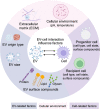A review of the regulatory mechanisms of extracellular vesicles-mediated intercellular communication
- PMID: 37055761
- PMCID: PMC10100201
- DOI: 10.1186/s12964-023-01103-6
A review of the regulatory mechanisms of extracellular vesicles-mediated intercellular communication
Abstract
Extracellular vesicles (EVs) are small, membrane-bound structures that are released from cells into the surrounding environment. These structures can be categorized as exosomes, microvesicles, or apoptotic vesicles, and they play an essential role in intercellular communication. These vesicles are attracting significant clinical interest as they offer the potential for drug delivery, disease diagnosis, and therapeutic intervention. To fully understand the regulation of intercellular communication through EVs, it is essential to investigate the underlying mechanisms. This review aims to provide a summary of the current knowledge on the intercellular communications involved in EV targeting, binding, and uptake, as well as the factors that influence these interactions. These factors include the properties of the EVs, the cellular environment, and the recipient cell. As the field of EV-related intercellular communication continues to expand and techniques improve, we can expect to uncover more information about this complex area, despite the current limitations in our knowledge.
Keywords: EV biogenesis; EV uptake; Exosome; Extracellular vesicle; Intercellular communication.
© 2023. The Author(s).
Conflict of interest statement
The authors declare no competing interests.
Figures



Similar articles
-
Transcriptome of Extracellular Vesicles: State-of-the-Art.Front Immunol. 2019 Feb 28;10:202. doi: 10.3389/fimmu.2019.00202. eCollection 2019. Front Immunol. 2019. PMID: 30873152 Free PMC article. Review.
-
Extracellular vesicles (EVs)' journey in recipient cells: from recognition to cargo release.J Zhejiang Univ Sci B. 2024 Aug 15;25(8):633-655. doi: 10.1631/jzus.B2300566. J Zhejiang Univ Sci B. 2024. PMID: 39155778 Free PMC article. Review.
-
Focus on Extracellular Vesicles: New Frontiers of Cell-to-Cell Communication in Cancer.Int J Mol Sci. 2016 Feb 6;17(2):175. doi: 10.3390/ijms17020175. Int J Mol Sci. 2016. PMID: 26861306 Free PMC article. Review.
-
Circulating Extracellular Vesicles As Biomarkers and Drug Delivery Vehicles in Cardiovascular Diseases.Biomolecules. 2021 Mar 5;11(3):388. doi: 10.3390/biom11030388. Biomolecules. 2021. PMID: 33808038 Free PMC article. Review.
-
Regulatory Role of Immune Cell-Derived Extracellular Vesicles in Cancer: The Message Is in the Envelope.Front Immunol. 2020 Jul 16;11:1525. doi: 10.3389/fimmu.2020.01525. eCollection 2020. Front Immunol. 2020. PMID: 32765528 Free PMC article. Review.
Cited by
-
Ionizing radiation effects on blood-derived extracellular vesicles: insights into miR-34a-5p-mediated cellular responses and biomarker potential.Cell Commun Signal. 2024 Oct 2;22(1):471. doi: 10.1186/s12964-024-01845-x. Cell Commun Signal. 2024. PMID: 39358789 Free PMC article.
-
Proteomics Studies on Extracellular Vesicles Derived from Glioblastoma: Where Do We Stand?Int J Mol Sci. 2024 Sep 10;25(18):9778. doi: 10.3390/ijms25189778. Int J Mol Sci. 2024. PMID: 39337267 Free PMC article. Review.
-
Neuroinflammatory responses and blood-brain barrier injury in chronic alcohol exposure: role of purinergic P2 × 7 Receptor signaling.J Neuroinflammation. 2024 Sep 28;21(1):244. doi: 10.1186/s12974-024-03230-4. J Neuroinflammation. 2024. PMID: 39342243 Free PMC article.
-
Extracellular vesicle production: A bidirectional effect in the interplay between host and Candida fungi.Curr Res Microb Sci. 2024 Jun 22;7:100255. doi: 10.1016/j.crmicr.2024.100255. eCollection 2024. Curr Res Microb Sci. 2024. PMID: 39040088 Free PMC article. Review.
-
Beyond Macromolecules: Extracellular Vesicles as Regulators of Inflammatory Diseases.Cells. 2023 Jul 29;12(15):1963. doi: 10.3390/cells12151963. Cells. 2023. PMID: 37566042 Free PMC article. Review.
References
-
- Théry C, et al. Minimal information for studies of extracellular vesicles 2018 (MISEV2018): a position statement of the International Society for Extracellular Vesicles and update of the MISEV2014 guidelines. J Extracell Vesicles. 2018;7(1):1535750. doi: 10.1080/20013078.2018.1535750. - DOI - PMC - PubMed
Publication types
MeSH terms
LinkOut - more resources
Full Text Sources
Research Materials

